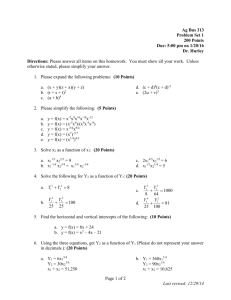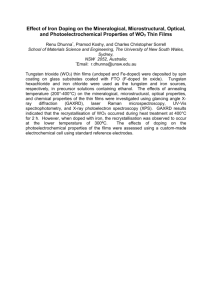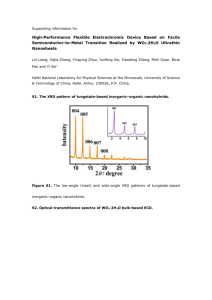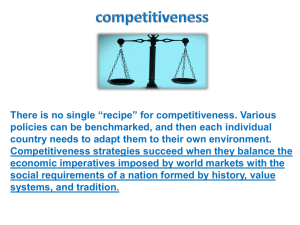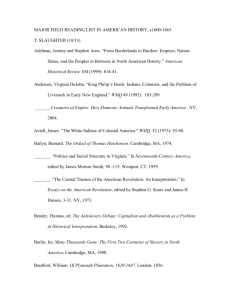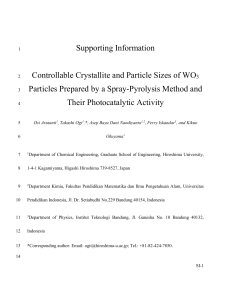Supporting Information:
advertisement
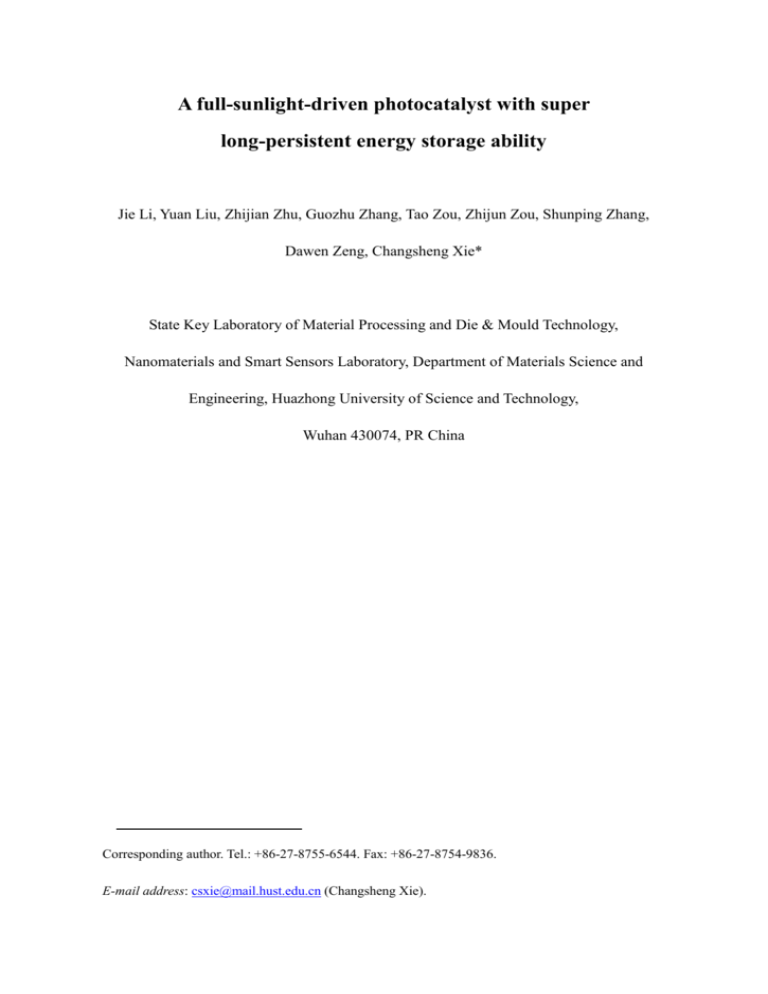
A full-sunlight-driven photocatalyst with super long-persistent energy storage ability Jie Li, Yuan Liu, Zhijian Zhu, Guozhu Zhang, Tao Zou, Zhijun Zou, Shunping Zhang, Dawen Zeng, Changsheng Xie* State Key Laboratory of Material Processing and Die & Mould Technology, Nanomaterials and Smart Sensors Laboratory, Department of Materials Science and Engineering, Huazhong University of Science and Technology, Wuhan 430074, PR China Corresponding author. Tel.: +86-27-8755-6544. Fax: +86-27-8754-9836. E-mail address: csxie@mail.hust.edu.cn (Changsheng Xie). Supporting Information: High-resolution transmission electron microscope (HRTEM) observations were performed with a JEOL 2100F microscope. The general surface morphology of the film was observed by field-emission gun scanning electron microscopy (FE-SEM) using a Hitachi S-4800 field-emission at a voltage of 10 kV, and energy dispersive X-ray (EDX) spectrum was also carried out with it. The X-ray diffraction (XRD) patterns were recorded on a Philips X’Pert diffractometer from 2θ = 10 to 70° using Cu-Kα radiation (λ = 1.5406 Å). Raman spectroscopy measurements were carried out with an FRA 106/s Raman spectrometer instrument attached to a Bruker VERTEX 70 infrared spectrometer. The laser wavelength was 1064 nm. Solid-state 1 H MAS (magic angle spinning) NMR experiments were carried out on a Bruker Avance III spectrometer at a resonance frequency of 400.23 MHz for 1H nuclei by using a combination of single-pulse experiments with high-speed MAS. Single-pulse (3.6μs pulse width) excitation corresponding to a π/2 flip angle with a repetition time of 3 s was used. An ultrahigh-speed 4mm Bruker MAS probe at a sample spinning rate of 15 kHz was used. The chemical shift values were referred to tetramethylsilane (TMS). All 1 H MAS NMR measurements were performed at room temperature. Figure S1. SEM images of the pristine WO3 (a) and the hydrogen treated WO3 (b). SEM images reveal that the pristine WO3 consists of 40–100 nm particles, while the hydrogen treated samples has particles within the same range. SEM images also evidence that there was no obvious growth in particle size and morphology change after hydrogen treatment. Figure S2. XRD Patterns of samples. Powder XRD patterns reveal that pristine WO3 consists of pure monoclinic WO3 (JCPDS No. 72-1465), and that hydrogen treated WO3 is made of W20O56 (JCPDS No. 05-0387). There is no obvious shift in the diffraction peaks between the pristine WO3 and the Pt loaded WO3. And there is hardly any difference between hydrogen treated WO3 and the Pt loaded treated WO3. This shows that the reduced samples have an oxygen-deficient structure. And the subsequent thermal treatment of loading Pt doesn't change the structure of as-prepared samples. Figure S3. Representative HRTEM images of samples. (a), (b) WO3; (c), (d) H:WO3; (e), (f), (g) Pt-H:WO3; (h), (i), (j) Pt-WO3. On the HRTEM images of the pristine WO3 and the hydrogen treated WO3, the observed lattice distances match the (2 0 0) planes of monoclinic WO3, and the (4 0 3) planes of W20O56, respectively. It confirms the XRD results. On the HRTEM images of Pt-WO3 and Pt-H:WO3, besides the (2 0 2) planes of monoclinic WO3 and the (1 1 6) planes of W20O56, the (1 1 1)planes of Pt is also shown, proving that Pt have been loaded successfully. And the images show that platinum particles around 3~5 nm are uniformly deposited on the surface of WO3 and W20O56 particles. Figure S4. EDX for Pt loaded samples: (a) Pt-WO3, (b) Pt-H:WO3 As seen from this figure, small peaks appeared at 2.0 keV represent the M electronic shell of Pt. It indicates a ~3 wt % of Pt loading in Pt-WO3 and Pt-H:WO3 samples. Figure S5. Raman spectra of the pristine WO3 and hydrogen-treated WO3 samples Figure S6. 1H MAS NMR spectra of WO3, H:WO3 and Pt-H:WO3 MAS NMR has been proven to be a powerful technique for characterizing surface hydroxyl groups1. The peaks of WO3 at around 1.0 ppm, 5.0 ppm and 6.8 ppm represent protons of surface terminal hydroxyl groups, bridging hydroxyl groups and surface absorbed water respectively1-4. The spectrum of H:WO3 is dramatically different from WO3, showing differences in peak position and relative intensity, which should be ascribed to the hydroxyl groups hydrogen treatment induced, different with absorbed hydroxyl groups in chemical nature. Almost the same location and relative intensity of peaks in the spectrum of Pt-H:WO3 with that of WO3 suggests that hydrogenated hydroxyl groups are removed, after Pt loading. Thus we can conclude that hydroxyl groups on the surface do not make a substantial contribution to the outstanding performance of Pt-H:WO3. 1H Supplementary Table 1 Summary of ratios of surface W6+/W5+/W4+ and O2-/OH-/H2O species of samples. W6+ W5+ W4+ O2- OH- H2O O/W WO3 35.30eV 100% / / / / 76.31% 10.32% 13.36% 3.176 H:WO3 36.12eV 49.20% 35.56eV 36.02% 34.21eV 14.78% 71.24% 23.25% 5.51% 2.788 Pt-WO3 35.43eV 100% / / / / 80.49% 11.37% 8.14% 2.910 Pt-H:WO3 35.85eV 53.44% 35.20eV 46.56% / / 83.36% 14.21% 2.43% 2.775 Supplementary References 1 Jiang, Y., Scott, J. & Amal, R. Exploring the relationship between surface structure and photocatalytic activity of flame-made TiO2-based catalysts. Applied Catalysis B: Environmental 126, 290-297 (2012). 2 Szilágyi, I. M. et al. WO3 photocatalysts: Influence of structure and composition. Journal of Catalysis 294, 119-127 (2012). 3 Lunk, H. J., Ziemer, B., Salmen, M. & Heidemann, D. What is behind ‘tungsten blue oxides’? International Journal of Refractory Metals and Hard Materials 12, 17-26 (1993). 4 Lunk, H. J., Salmen, M. & Heidemann, D. Solid-state1H NMR studies of different tungsten blue oxides and related substances. International Journal of Refractory Metals and Hard Materials 16, 23-30 (1998).
